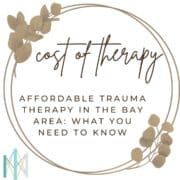
You know you need help processing your trauma. Maybe it’s PTSD from a difficult experience, anxiety that traces back to childhood wounds, or depression rooted in unresolved grief. You’ve started researching trauma therapy in the Bay Area, and you’ve discovered something both exciting and overwhelming: there are dozens of specialized approaches, from Brainspotting to EMDR to Somatic Experiencing to Internal Family Systems.
But here’s the challenge. In the San Francisco Bay Area, where the cost of living ranks among the highest in the nation, accessing specialized trauma therapy often feels financially out of reach. You might assume that working with a therapist trained in these specific modalities means paying premium rates that strain or break your budget.
The good news? Affordable trauma therapy Bay Area options exist that don’t require you to compromise on specialized care or treatment quality. Understanding how different care models work, what trauma therapy approaches are available, and how to find well trained therapists at accessible rates can open doors you might have thought were closed.
This guide walks you through everything you need to know about accessing quality trauma treatment in the Bay Area, including the diverse approaches available and how to find the right match for your healing journey.
Browse our Therapist Directory
The reality of therapy costs in the Bay Area

Why specialized trauma therapy feels inaccessible
The Bay Area’s cost of living affects every profession, including mental health care. Therapists face the same inflated rent, transportation, and living costs as everyone else. When you add in the years of specialized training required for trauma modalities, student loan debt from graduate programs, and ongoing continuing education costs, it’s easy to see why therapy fees can feel prohibitive.
This creates a painful paradox for trauma survivors. The Bay Area has some of the best trained trauma therapists in the country, with expertise in cutting edge modalities and neuroscience informed approaches. Yet this concentration of specialized knowledge often comes with price tags that put treatment out of reach for many people who need it most.
Trauma itself often impacts your ability to work consistently or advance in your career. The symptoms you’re trying to heal may be the very things making it harder to afford the healing you need.
Research confirms this painful paradox. A 2020 study published in the journal European Psychiatry examined nearly 1,650 working adults and found that those who experienced childhood trauma showed significantly higher rates of both absenteeism and reduced work performance compared to those without trauma histories. Workers with severe childhood trauma were twice as likely to experience long term work absences as those without trauma backgrounds.
The impact goes beyond missed days. Even when trauma survivors show up to work, their performance often suffers. The study found that workers with trauma histories scored notably higher on workplace disability measures, meaning they struggled more with completing daily work tasks, meeting deadlines, and performing at their usual capacity. Depression and anxiety stemming from unresolved trauma accounted for much of this reduced work functioning.
This creates a vicious cycle. Trauma symptoms like hypervigilance, emotional dysregulation, difficulty concentrating, and relationship challenges affect your ability to succeed at work. Reduced work performance can lead to fewer advancement opportunities, lower income, or job instability. Limited financial resources then make it harder to access the trauma treatment that could improve your work functioning. Meanwhile, the stress of financial insecurity often worsens trauma symptoms.
Breaking this cycle requires accessible trauma care that doesn’t depend on the high income that trauma itself makes difficult to achieve or maintain.
The cost of not treating trauma
While therapy requires financial investment, untreated trauma carries its own costs. PTSD and complex trauma affect your work performance, relationships, physical health, and quality of life. You might find yourself missing work due to symptoms, struggling to maintain relationships, or developing stress related health problems that create their own medical expenses.
The question isn’t whether you can afford trauma therapy. It’s whether you can afford to continue living with unprocessed trauma. Finding accessible pathways to quality care becomes essential, not optional.
Understanding the Associate MFT model
What makes associate care different
Associate Marriage and Family Therapists (AMFTs) represent a often misunderstood pathway to accessing specialized trauma treatment. These therapists have completed their master’s degrees in counseling or marriage and family therapy, including comprehensive training in trauma treatment, psychopathology, therapeutic techniques, and ethics.
The difference between an associate and a fully licensed therapist isn’t education or knowledge. Associates completed the same rigorous graduate programs as licensed therapists. The distinction is experience level and the requirement for ongoing clinical supervision. In California, associates must complete 3,000 supervised clinical hours before becoming fully licensed, a process that typically takes two to three years.
Why this model increases accessibility
The associate model creates a unique opportunity for accessible mental health care. Associates are building their practices and clinical experience, which often translates to more accessible rates than fully licensed providers. This isn’t because the care is inferior. Associates bring fresh knowledge from recent training, enthusiasm for their work, and dedication to building strong therapeutic relationships.
At Center for Mindful Therapy, our collective of approximately 140 Associate MFTs means we can offer specialized trauma treatment throughout the San Francisco Bay Area at rates that make consistent weekly therapy feasible for more people. Our associates train in the same specialized modalities as expensive private practitioners, but the supervised practice model allows for greater accessibility.
The quality advantage of supervised care
Some people worry that seeing an associate means receiving lesser care. Understanding how clinical supervision actually works reveals why this concern is unfounded. Every associate works under a licensed clinical supervisor who reviews their cases regularly, provides guidance on treatment planning, and ensures adherence to best practices.
This means your treatment is effectively being overseen by two experienced clinicians. Your associate therapist provides your direct care, while their supervisor offers additional expertise and perspective on your case. If your associate encounters complex dynamics or challenging situations, they consult their supervisor before your next session.
Associates also tend to carry smaller caseloads than fully established therapists, allowing them to give each client more attention and care. Many bring current research and emerging approaches from their recent graduate training. The combination of fresh knowledge, careful attention to each client, and ongoing supervisory oversight creates a strong foundation for effective trauma treatment.
Specialized trauma therapy approaches available
Brain based trauma therapies
Modern neuroscience has revolutionized how we understand and treat trauma. Several approaches work directly with how your brain stores and processes traumatic experiences, bypassing the limitations of talk therapy alone.
Brainspotting uses specific eye positions to locate and process trauma stored in subcortical brain regions. Developed in 2003, this approach accesses your nervous system directly through the brain eye connection. Where you look affects how you feel, and by identifying eye positions that correlate with trauma activation, your therapist helps you process material that verbal therapy cannot reach. [LINK: Learn more about Brainspotting therapy → /brainspotting-therapy-san-francisco-bay-area/] and how it works with the brain body connection.
Eye Movement Desensitization and Reprocessing (EMDR) helps your brain reprocess traumatic memories through bilateral stimulation, typically eye movements. This evidence based approach has strong research support for PTSD and trauma related conditions. Unlike traditional therapy, EMDR doesn’t require you to talk extensively about your trauma while still achieving significant symptom reduction.
Both approaches demonstrate effectiveness for single incident trauma and complex developmental trauma. Many of our Bay Area associates train extensively in these brain based modalities, making them accessible to clients throughout San Francisco, Oakland, Berkeley, and surrounding communities.
Body centered trauma approaches
Trauma lives in your body, not just your mind. Somatic approaches recognize that your nervous system stores traumatic experiences physically, creating symptoms like chronic tension, pain, hypervigilance, and disconnection from your body.
Somatic Experiencing helps you complete the self protective responses your body began during trauma but couldn’t finish. When you experience threat, your nervous system activates fight, flight, or freeze responses. If these responses get interrupted or overwhelmed, the activation remains stuck in your system. Somatic Experiencing guides you to slowly release this stored activation, restoring regulation to your nervous system.
Sensorimotor Psychotherapy integrates talk therapy with body awareness and movement. Your therapist helps you notice how trauma shows up in your posture, gestures, and physical sensations, then works with these body patterns to process traumatic material. This approach recognizes that your body holds wisdom about your trauma that your conscious mind may not access.
These body based approaches work particularly well for people who feel disconnected from their bodies, experience unexplained physical symptoms, or find that talking about trauma doesn’t create the relief they seek.
Parts based trauma therapy
Internal Family Systems (IFS) understands your psyche as containing multiple parts, each with its own perspective, feelings, and role. Trauma often creates protective parts that help you survive difficult experiences but may interfere with your life later. Some parts might push down painful feelings, while others stay hypervigilant for danger.
IFS therapy helps you develop a compassionate relationship with all your parts, including the young, wounded parts carrying your trauma. Rather than trying to eliminate symptoms or change parts, you learn to understand what each part is trying to protect you from. This understanding allows natural healing to unfold.
Many trauma survivors find IFS particularly powerful because it doesn’t pathologize their symptoms. Instead, it honors that every part developed for good reason and deserves compassion. Several of our associates throughout the Bay Area specialize in integrating IFS with other trauma modalities.
Attachment focused trauma therapy
Much trauma occurs in the context of relationships, particularly early attachment relationships with caregivers. When the people meant to protect you were also sources of harm, fear, or inconsistency, your nervous system develops complex adaptations that affect all future relationships.
Attachment focused therapy addresses these relational wounds directly. Your therapist provides a corrective emotional experience through the therapeutic relationship itself, offering the consistency, attunement, and safety your early relationships lacked. Over time, this secure base allows you to revisit and heal attachment trauma.
This approach often integrates with other modalities. You might use Brainspotting to process specific attachment wounds, or IFS to work with protective parts that formed in response to early relational trauma. The therapeutic relationship becomes both the method and the medicine.
Cognitive and emotion focused approaches
While trauma often requires more than traditional talk therapy, some approaches that include cognitive and emotional processing remain valuable, especially when integrated with body based or brain based work.
Cognitive Processing Therapy (CPT) helps you identify and challenge unhelpful thoughts that developed around your trauma. If you blame yourself for what happened or developed negative beliefs about yourself, the world, or others, CPT provides structured ways to examine and shift these patterns.
Emotion Focused Therapy (EFT) helps you access, process, and transform difficult emotions. Rather than trying to think your way out of emotional pain, you learn to move through emotions in adaptive ways. This approach recognizes that emotions contain important information and healing happens through experiencing, not avoiding, your feelings.
Many therapists integrate these approaches with somatic or brain based work, creating comprehensive treatment that addresses trauma on multiple levels simultaneously.
How associates develop specialized trauma training
Graduate education foundations
Every Associate MFT completed a master’s program requiring extensive coursework in trauma theory and treatment. These programs teach foundational knowledge about how trauma affects the brain, nervous system, attachment, and development. Students learn multiple therapeutic approaches and begin developing their clinical skills through practicum placements.
However, graduate programs provide breadth rather than depth in any single modality. To develop true expertise in approaches like Brainspotting, EMDR, or Somatic Experiencing, therapists pursue additional specialized training after graduation.
Specialized modality training
Most specialized trauma modalities require extensive post graduate training. Brainspotting certification involves multiple phases of training, each consisting of several intensive days learning the approach. EMDR requires completion of approved training programs spanning months. Somatic Experiencing training unfolds over three years.
Our associates invest in these specialized trainings while working under supervision. This combination means you benefit from their fresh, specialized knowledge while also receiving the oversight of experienced supervisors. You get specialized trauma treatment without the premium price tag that fully licensed specialists typically command.
Ongoing consultation and development
Beyond formal training, effective trauma therapists engage in ongoing consultation with colleagues, attend workshops and conferences, and stay current with trauma research. The field of trauma treatment evolves rapidly as neuroscience reveals new insights about healing.
Many of our associates participate in consultation groups specific to their modalities, connecting with other Brainspotting therapists, EMDR practitioners, or somatic specialists. This ongoing learning ensures your treatment reflects current best practices and benefits from collective wisdom within each approach.
Finding the right trauma therapy approach for you
Matching symptoms to approaches
Different trauma presentations often respond particularly well to specific modalities. If you experience intrusive flashbacks and nightmares, brain based approaches like Brainspotting or EMDR may provide rapid relief. If you feel disconnected from your body or experience unexplained physical symptoms, somatic approaches might resonate more.
For relationship difficulties rooted in attachment trauma, you might benefit from attachment focused work. If you struggle with self criticism or feeling fragmented, IFS could be especially helpful. Many therapists integrate multiple approaches, tailoring treatment to your specific needs.
Considering your learning and processing style
Think about how you naturally process information and experience. Do you tend to be cognitive and analytical? You might appreciate approaches that include some cognitive elements alongside experiential work. Are you naturally attuned to your body? Somatic approaches might feel intuitive.
Some people need to understand the theory behind their treatment, while others prefer to simply experience the process. Consider what helps you feel safe and engaged. The best trauma therapy is the one you’ll actually attend consistently.
The importance of the therapeutic relationship
Research consistently shows that the quality of the therapeutic relationship matters as much as the specific modality used. You need a therapist you trust, who makes you feel safe, and whose style resonates with you. The most perfectly matched modality won’t help if the relationship doesn’t feel right.
Our online directory allows you to read therapist profiles, learning about their training, approach, and personality. Many therapists offer free consultations where you can ask questions and sense whether you feel comfortable with them. Take time finding someone who feels like a good fit.
In person and telehealth considerations
Many of our associates throughout the San Francisco Bay Area offer both in person sessions at various locations and telehealth throughout California. For some trauma work, particularly somatic approaches, in person sessions may feel important. Other modalities translate remarkably well to telehealth. You can choose what feels right for you.
Consider your own preferences and practical constraints. If you have transportation limitations or a demanding schedule, telehealth offers more flexibility. If being in the same physical space as your therapist feels important for your sense of safety, seek associates offering in person options in San Francisco, Oakland, Berkeley, or other Bay Area locations convenient to you.
Taking the first step toward healing
Browsing our therapist directory
Start by exploring our therapist directory where you can filter by specialty and modality. Look for associates trained in approaches that resonate with you, whether that’s Brainspotting, EMDR, Somatic Experiencing, IFS, or other trauma focused modalities.
Read profiles carefully. Notice who addresses concerns similar to yours, who has training in approaches you’re curious about, and who simply resonates with you on an intuitive level. Pay attention to their described therapy style and the populations they work with.
Reaching out for consultations
Many of our associates offer free brief phone consultations before you commit to a first session. Use these conversations to ask about their experience with your specific concerns, their approach to trauma treatment, and their availability.
This is also your chance to notice how you feel talking with them. Do they listen well? Do you feel comfortable? Does their style match what you’re looking for? Trust your instincts about therapeutic fit.
What to expect in your first session
Your initial session typically involves your therapist getting to know you, your history, and your goals for treatment. They’ll explain their approach and answer your questions. Together you’ll discuss whether their modality and style feel like a good match for your needs.
You don’t have to dive into your trauma story immediately. Good trauma therapists pace the work according to your readiness and help you build resources before processing difficult material. Healing happens when you feel safe enough to let your nervous system begin releasing what it’s been holding.
Making trauma therapy sustainable
Trauma healing is a journey, not a quick fix. Most people benefit from consistent weekly sessions over several months at minimum. Consider what you can sustain long term rather than starting intensively and burning out.
The associate model at Center for Mindful Therapy makes this sustainability more feasible. You can access specialized trauma treatment from well trained therapists throughout your healing process without the financial strain that might force you to stop treatment prematurely.
When you’re ready to begin
Reaching out for trauma therapy takes courage. Your trauma may tell you that healing isn’t possible, that you don’t deserve help, or that nothing will work. These are trauma responses, not truths. Healing is possible, you deserve support, and effective trauma treatment does work.
Contact us to ask questions about our services or specific therapists. Our team can help connect you with associates who specialize in your concerns and have availability. You can also reach out directly to therapists whose profiles resonate with you.
The right trauma therapy, with the right therapist, at a rate you can sustain, exists. Your healing journey can begin today.
Browse our Therapist Directory
Related resources
Interested in learning more about different types of trauma? Explore our roundup of trauma types addressed in therapy.
Want to know what it means to experience trauma-informed therapy? Learn about this important foundation of therapy for trauma here.
Citations:
- De Venter, M., Elzinga, B. M., Van Den Eede, F., Wouters, K., Van Hal, G. F., Veltman, D. J., Sabbe, B. G. C., & Penninx, B. W. J. H. (2020). The associations between childhood trauma and work functioning in adult workers with and without depressive and anxiety disorders. European Psychiatry, 63(1), e76. https://doi.org/10.1192/j.eurpsy.2020.70






